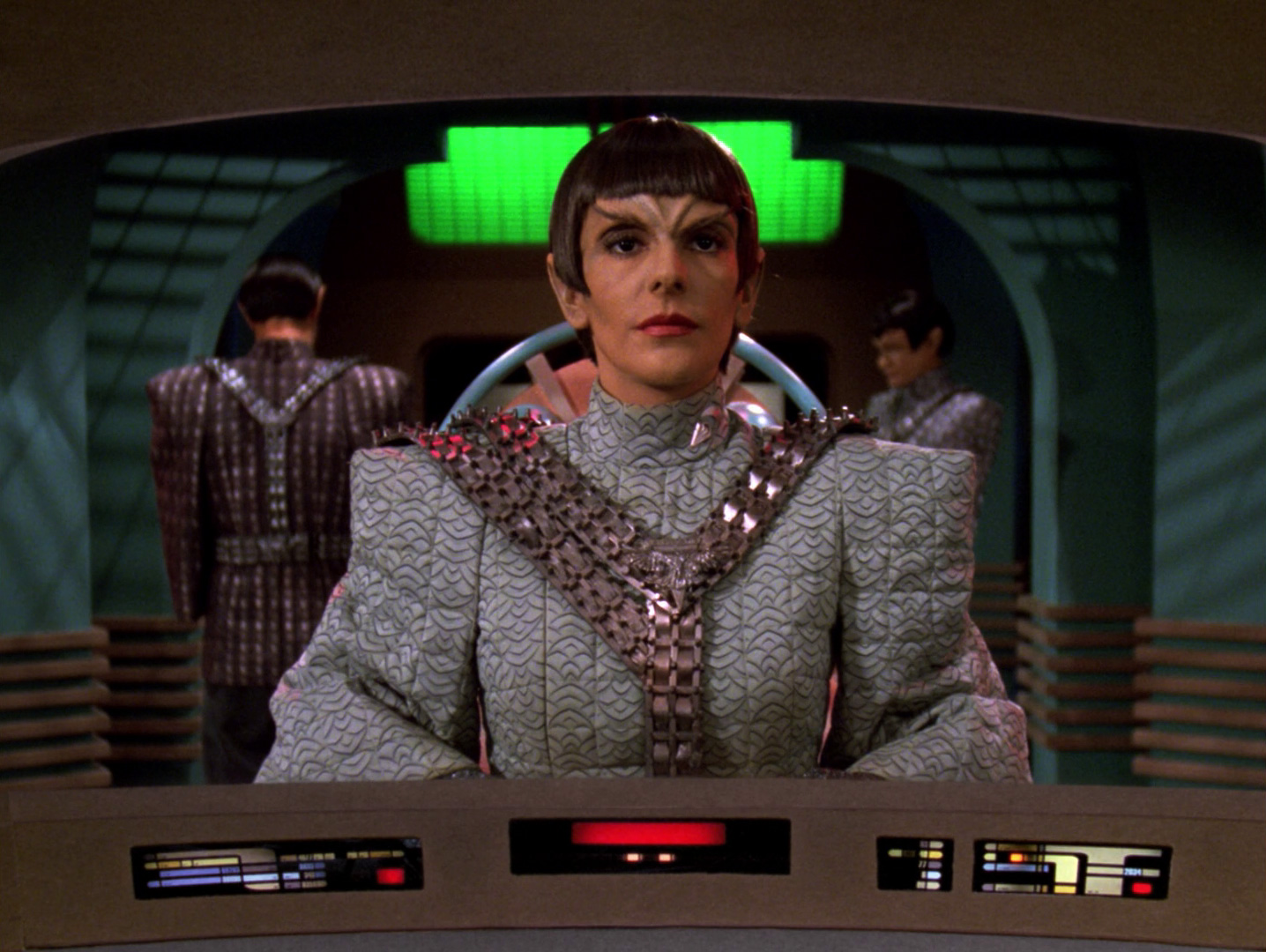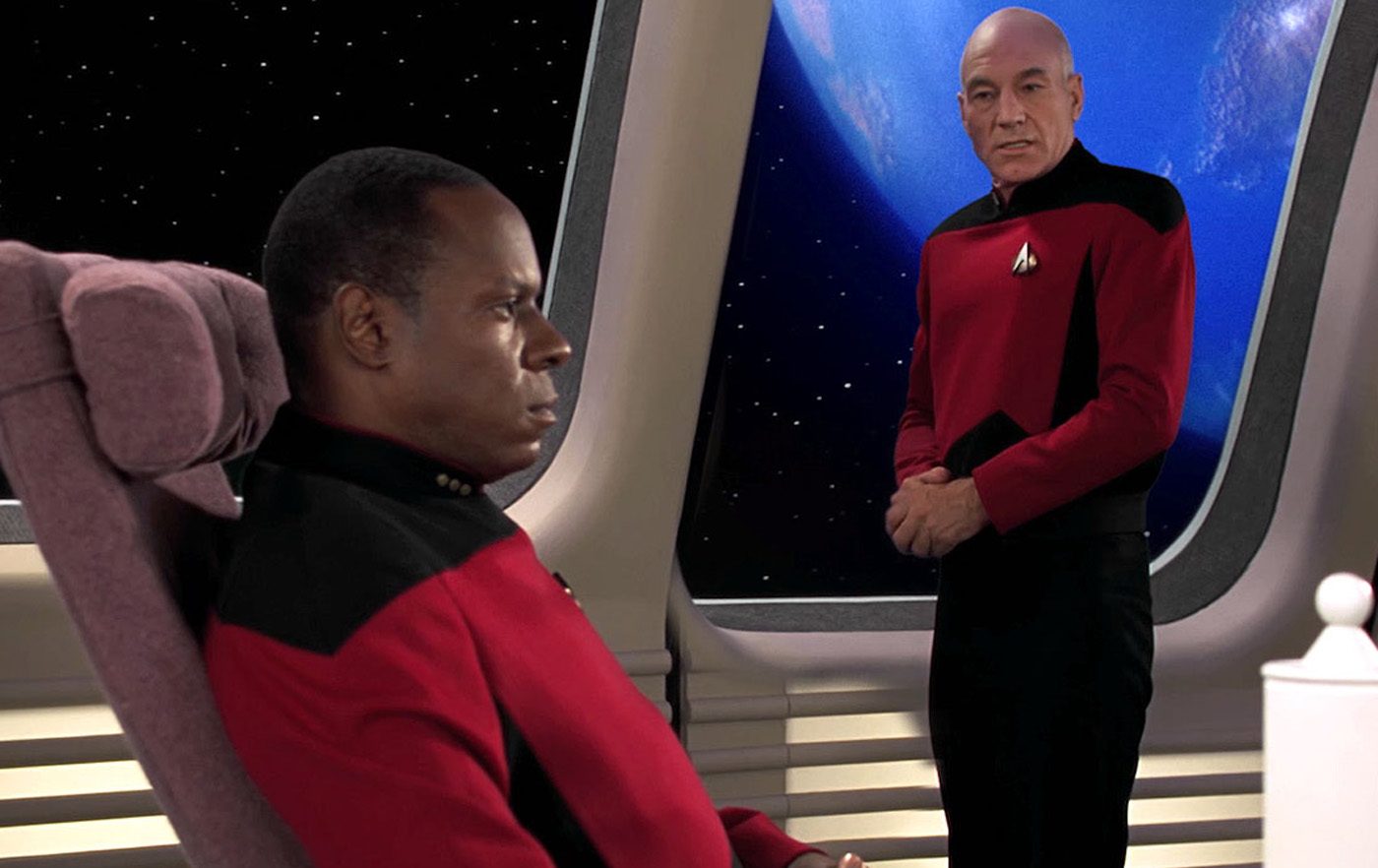The date is June 15, 1991. The stardate is 44995.3. And Star Trek is about to change forever. But why? And how?
Within the 24th century universe of Star Trek: The Next Generation, the burgeoning Klingon Civil War galvanizes Lieutenant Worf to resign his Starfleet commission and join the fight. Meanwhile, bigger and more far-reaching changes to Star Trek are happening in the real world.
Between the episodes “Redemption” and “Redemption Part II” the global landscape shifts as does controlling hands at series parent company Paramount. Star Trek will never be the same again even though most of us won’t realize it until years later.
So what exactly happens between June and September ’91? Let’s zoom all the way out first.
Star Trek takes its cues from the real world all the time. And this particular moment in Star Trek is no exception. The Klingon Civil War’s genesis is rooted in the machinations between the Duras family and the Romulans.
Hostilities between the Romulan Empire and the Federation often draw heavy inspiration from the ones between the United States of America and the Soviet Union. But as the Romulan Empire attempts to fracture peace between the Klingons and the Federation, the real world Cold War is taking a drastically different turn.
While the beginning of the end of the Cold War is largely marked by the fall of the Berlin Wall in November 1989, it is not until July 1991 that Gorbachev and Bush sign START I, thus agreeing to bring significant reduction in military hostilities between the two super powers.
Throughout that summer into the fall, the U.S.S.R. continues to fracture into independent nations. And in September, President Bush ends the Cold War Alert. No longer would B-52 Bombers be at the ready to defend against Russian nuclear attack.
How will these seismic changes in global politics shift the world of Star Trek? The franchise historically exists as both a mirror to our civilization and presupposition that we can find our way towards utopia. How will Star Trek respond to these events?
Pop culture, too, changes in enormous ways. In its September ’91 issue, Esquire Magazine discusses the shift away from the “wise guy” towards the “nice guy”. The likes of Jay Leno, Harry Connick Jr., and Kevin Costner were all on the rise. But while the upbeat, Full House-ification of modern television is in full swing, counterculture is also on the rise.
After years of underground growth for the alt. rock movement (and mere days before Star Trek: The Next Generation season five’s premiere), Nirvana unleashes “Smells Like Teen Spirit”. After over a decade of right wing dominance, an angry Gen X begins to assert itself.
How will Trek’s optimism be impacted by a disaffected generation increasingly tuned out from Roddenberry’s rosy, optimistic vision of the future? How will it contend with the rise of rage-baiting day-time television like Jerry Springer whose show also just so happens to begin airing in September ’91?
Imagine it: a whole generation of people sick of “nice guy” culture starts throwing chairs on national television. Every day. Here we are now. Entertain us.

There’s a lot we can hypothesize, but there is one man we can point to who, in this moment, sees the writing on the wall for television generally, Star Trek specifically, and begins to pivot: Brandon Tartikoff.
Star Trek and Brandon Tartikoff
People sometimes refer to the first two seasons of Star Trek: The Next Generation as a power vacuum, a time without definitive leadership. In 1991, Paramount experiences a similar vacuum as power shifts from Frank Mancuso to Stanley R. Jaffe and from David Kirkpatrick to Brandon Tartikoff.
Tartikoff only acts as Paramount Pictures chairman for one year. But in that one year, he alters the landscape of Star Trek (and television in general) in pretty profound ways.

For one thing, Tartikoff enters the proverbial fray towards the very end of production on Star Trek VI: The Undiscovered Country. At the time the understanding is that this is the last Trek film. Tartikoff, however, thinks otherwise. “Why does this have to be the last one?” Tartikoff sees the potential in TNG movies.
Tartikoff thinks this for two reasons. One, TNG is a huge success in syndication. Two, that success won’t last much longer, not on television anyway. As the series enters its fifth season, Tartikoff runs the numbers and concludes that seven is the number of seasons a show like TNG has before it reaches a period of significant diminishing returns.
But in addition to seeing a future for Star Trek in film, Tartikoff also still sees a future in television. And so he calls upon then head Trek honcho Rick Berman to begin the process of crafting a third live-action series.
Subscribe to our newsletter!
Get Tabletop, RPG & Pop Culture news delivered directly to your inbox.
In this brief period of time Tartikoff sets up: TNG movies, a seven season standard, and Star Trek: Deep Space Nine.
What About the Romulans?
You may be looking at Tarikoff and the fall of the Soviet Union and wondering: how do these things connect? Well, the answer is that they don’t. Not directly, anyway. However, in addition to Tartikoff’s offscreen evolution of Star Trek, we can see the impact of real world events on screen.

The Romulans feature enormously in Star Trek at the start of TNG‘s fifth season. First they attempt to start a Klingon civil war in “Redemption”. And then they attempt an invasion of Vulcan in “Unification”. Both stories feature the cunning leader Sela, the alternate universe daughter of Tasha Yar.
She never appears again.
As a matter of fact, the Romulans only appear a few more times on TNG. In “The Next Phase” they notably receive aide from the Enterprise, creating potential for an alliance. In “Timescape” the assumption is that the Romulans are attacking, but they aren’t!

And, most notably, in “Face of the Enemy” the last official “Unification” related story for decades, some of the Romulan Empire’s leadership is shown to be defecting. And Sela, who has been our face for Romulan leadership, doesn’t even get a namecheck.
The Romulans, one of the quintessential Federation enemies, nearly vanishes from our screens within a year. It’s hard not to look at this in hindsight and draw parallels. In the real world, the Soviet Union falls, in Star Trek the Romulans go from villains to potential, if-uneasy allies.
And Then There’s Star Trek: Deep Space Nine
Star Trek: The Next Generation is cozy as wall-to-wall carpeting. It’s a show where the good guys are good and the bad guys are at least misguided. The system works, more or less. And when it doesn’t there’s stalwart good guys like Jean-Luc Picard to right the ship.
Hey, remember how Gen X was sick of the notion of American exceptionalism? How they hated Reagan and wanted to uproot the system? But also how they felt kind of disaffected, powerless, and just generally angry? Where’s the Star Trek for them?
It’s funny. I didn’t think about this until I started writing this article, but Star Trek: Deep Space Nine, the series first requested by Brandon Tartikoff, is the Gen X Star Trek show.
Think about it. Benjamin Sisko is fed up with Starfleet. He’s lost his wife. He’s at the back end of the galaxy. And Sisko’s got to put up with Picard, the guy low key responsible for his wife’s death. He’s pretty anti-establishment about the whole thing!
And who is Sisko’s right hand? Kira Nerys. A former freedom fighter battling the provisional government of her homeworld Bajor because it’s in tatters after a generation-long occupation by the Cardassians. You’ll never believe it: she’s pretty anti-establishment, too.
Star Trek: Deep Space Nine may pay respect to Gene Roddenberry and his dream of a utopian future. But it doesn’t paint a rosy picture of the Federation. The good guys are not always good, even when they’re right. It’s a GenX show, through and through.
And the seeds for its origins are planted in 1991: the summer Star Trek changed forever and you didn’t even know it.
Don’t Miss:
Lina is a 10+ year entertainment journalist veteran whose bylines include SYFY Wire, Looper, and Screen Fanatic. She has written comic scripts for IDW Comics and Zenescope Enetertainment and has written Doctor Who shorts for BBC Worldwide. She is a long-time podcast host and producer who has worked on Who Won the Week, SYFY’s Every Day series, and the Amazon podcast Untold Story. She currently co-hosts the New York Times recommended podcast Song vs Song.
Read more at this site
